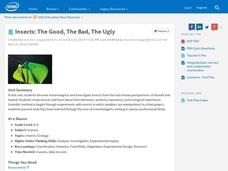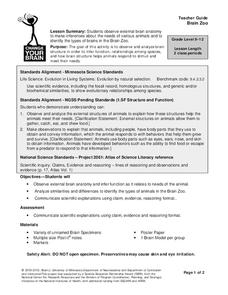Pace University
Grade 6-8 Living Things
What characterizes a living thing? Scholars explore the concept during a differentiated instruction unit on living things. They perform lab experiments to determine how animals adapt to stimuli, watch videos and learn about...
PBS
Stories of Painkiller Addiction: The Cycle of Addiction
Drug addiction, including prescription drug addiction, begins with a reason that's different for every user. High schoolers learn more about the reasons people begin abusing drugs with a set of videos and worksheets that discuss four...
PBS
Stories of Painkiller Addiction: Myth or Fact
Are opioids the most abused drug after marijuana? How hard is it for young people to obtain painkillers without a prescription? Middle and high schoolers explore the growing epidemic of opioid addiction with a instructional activity that...
PBS
Stories of Painkiller Addiction: Learning About Opioids
Feeling high is not the only side effect of abusing prescription opioids. Middle and high schoolers learn more about specific painkillers, including Fentanyl, Oxycodone, and Clonazepam, as well as their common brand names and extensive...
Scholastic
Recovery From Drug Addiction
Are there factors that put some individuals at a higher risk for drug addiction than others? Learn more about the risk factors that may make some people more susceptible to addiction, as well as protective factors that help prevent...
Scholastic
Prescription Pain Medication: What You Need to Know
The national epidemic of opioid addiction is making its way into high school populations. Educate the students in your class about the ways prescription opioids can both block pain and deliver large amounts of dopamine that make it very...
Intel
Insects: The Good, The Bad, The Ugly
What would the world be like with no insects? Ponder this question using a research-based STEM unit that encourages scholars to investigate insects from both a beneficial and hazardous perspective. They learn about insect behaviors,...
Community Resources for Science
A Whole New World of DNA and Proteins
Lead your young scientists into an exciting world as they participate in a role play and experiment focused on proteins and DNA. After researching the Central Dogma of Biology, individuals or groups participate in a classroom slide...
Scholastic
Study Jams! Animal Cells
Using stunning computer imagery, this resource introduces life science learners to cells. It zeros in on the animal cell and the function of its more prominent organelles. Additional support is offered in the form of a self-assessment...
Baylor College
Magnifying and Observing Cells
Though it isn't a novel activity to prepare onion cell and Elodea plant cell slides as examples of cells in a microbiology unit, this resource will leave you thoroughly prepared. As pupils examine the slides that they prepare, they draw...
University of Minnesota
Brain Zoo
Who doesn't love a day at the zoo? Use an observation and inference lab to get young anatomists to recognize similarities between mammalian species based on brain structures. You provide the brains; this lesson provides set-up...
University of Minnesota
Motor Learning and Memory
What do our brains have to do with reaction timing? Everything! In a hands-on learning activity, young scientists participate in four card activities that measure reaction timing. Each activity gets progressively more complex, and...
University of Minnesota
Makes Me Sweat
Never let them see you sweat ... unless you can't help it! Scholars design an experiment to determine the effects of stress on the body. They monitor sweat production under different conditions and relate the response to the function of...
University of Minnesota
Bead Neuron
What do you call a skull without neurons? A no-brainer! A hands-on activity asks scholars to build a model of a neuron using beads. They use their models to study the parts of the neuron and their functions.
Scholastic
Stressed Out?
Provide tweens and teens with information they need to know about stress with an article that details how stress affects various organs in the body. The article also offers tips for healthy ways to cope with stress.
Exploratorium
Antibody Attack - Discover How Antibodies Launch Attacks on Invaders
Jump into the action and help antibodies defend against an antigen attack! Investigators match antibodies with antigens to model the body's identification and recall of specific pathogens. Young biologists also recognize that each...
Brine Shrimp: Getting to Know a Salt Water Arthropod
Gather small observations of arthropods. Using brine shrimp, pupils observe the life cycle of arthropods. Learners set up saltwater aquariums and observe the brine shrimp over a three-week period. To finish, they compare and contrast how...
Exploratorium
Breakfast Proteins - Construct a Protein through Cereal Additions
Match my cereal sequence. Pupils view a sequence made by colorful cereal rings and create copies of it. Learners must either remember or write down the sequence to transport the code to another location. Scholars replicate the cereal...
Exploratorium
Life Size - Explore the Size and Scale of Microscopic Biology
Compare sizes of microscopic items. Given a set of labels of microscopic objects, pupils try to place them in order from smallest to largest. Scholars then compare their lists to the actual comparisons along with the measurements of the...
Exploratorium
Cellular Soap Opera - Soap Films Can Behave Like Membranes
Soap, suds, and cell membranes. Pupils create a model of a cell membrane by using soap films. They experiment with trying to pass different objects through the film without popping it. Using a tube, they create a passageway through the...
Exploratorium
Viral Packaging
Create a protective protein shell as a package. Using the included template, pupils tape together 20 triangles to create a 20-sided shape to represent the protective shell of a virus. The model of the protein shell incases the nucleic...
American Museum of Natural History
Gusty: The Gut Microbiome Card Game
Build up your gut. Groups up to four play a card game to learn more about the microbiome in the gut. Learners try to build a healthy gut with their cards. The player acquiring six microbes without any pathogens wins the game.
Museum of Science
Strawberry DNA
Humans aren't the only ones with DNA—fruit has it too. Using a extraction solution, pupils pull the DNA out of a piece of fruit. Learners crush up a piece of fruit with the solution and filter out the solids. Scholars then add cold...
American Museum of Natural History
Differentiate! The Stem Cell Card Game
Let the games grow. Groups play a card game to grow cells. Players start growing cells from stem cells to create specialized cells in the human body. Learners use full-grown cells from the human body to create stem cells in the lab to...

























